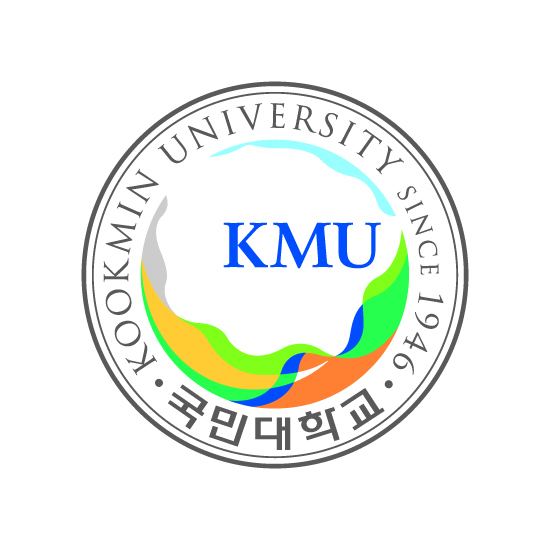Chairman Chaegyeom Kim Academic staff 1,702 (2014) Mascot Dragon Founded September 1946 Undergraduates 15,493 | Established September, 1946 President Jisoo Yu Phone +82 2-910-4114 Total enrollment 18,224 (2014) Motto 이교위가 (C3, 以校爲家) | |
 | ||
Motto in English C3 (Change, Chance, Challenge) Notable alumni Sohn Suk‑hee, Lee Hyori, Uhm Tae‑woong, Chung Doo‑un, So Hyun‑kyung Similar Konkuk University, Chung‑Ang University, Dankook University, Kyung Hee University, Sejong University Profiles | ||
Kookmin university campus mel in seoul
Kookmin University (hangul:국민대학교, hanja:國民大學校) is the first national private university located in Seongbuk-gu, Seoul, South Korea after the liberation of the Republic of Korea from Japan. Kookmin University was established in 1946. After South Korea was liberated from Japan, Gu kim, Soang Jo and Ikhee Shin who are the members of the cabinet in a provisional government had agreed to cultivate a great leader among the Republic of Korea in perspective, which soon became the banner of the Kookmin University. Ikhee Shin who is one of the key figures of establishment for the Kookmin University was inaugurated as the first president of the University. Kookmin University is owned by the SsangYong Group, which bought the university in 1959.
Contents
- Kookmin university campus mel in seoul
- kookmin university
- History
- Academics
- Exchange programs
- Korean language programs
- Campus
- Academic Administrative Buildings
- Research institutes
- Major accomplishments since 1996
- References
Kookmin University has an academic family of 22,000 students, about 800 faculty members and 350 administrative staff. Since its establishment in 1946, approximately 60,000 students have graduated.
Kookmin University includes the College of Humanities, the College of Engineering and 12 other colleges. The university includes a Graduate school which consists of three Professional Graduate Schools and ten Special Graduate Schools.
Kookmin teaches in the fields of Design, Architecture, Automotive Engineering, Techno-Design, Social Science and other academic disciplines.
The College of Design held the first rank in three fields and the second rank in two fields among a total of five fields as a result of a nationwide assessment in 2007 in South Korea. The college has been ranked among the top three departments in Korea with Seoul National University and Hongik University.
Kookmin University's Graduate School of Techno Design, which was established with the view of nurturing "design human capability of world level", has been selected for the BK (Brain Korea) 21 project. The Techno Design School's interdisciplinary connection and expertise in educational-industrial cooperation is expected to create synergy with the "UIT design".
In the Joongangilbo University Ranking 2011, the School of Economics achieved third in Korea.
kookmin university
History
Kookmin University was established by the cabinet members of the Shanghai Provisional Government while the Korean government was in exile under the Japanese occupation. Ikhee "Haikong" Shin became the first president of the university. He went on to serve the country as the first House Speaker of the National Assembly.
In 1959 Sunggon "Sungkok" Kim, the founder of the SsangYong Group, took over the foundation.
Surrounded by the Bukhansan National Park, Kookmin University boasts a clean and green environment.
Presently, Kookmin University consists of 23,000 students, 700 faculty and 300 staff members. There are 13 colleges and 14 graduate schools.
Academics
Kookmin University's academic programs are organized into undergraduate colleges, graduate schools, professional, and special schools.
Exchange programs
Kookmin University invites more than 450 exchange students from 100 sister universities annually. At Kookmin University scholarship is granted to exchange students. 800,000 Won per semester is awarded to incoming exchange students up to 2 semesters.
Korean language programs
The previous Korean Language Center has been incorporated and expanded to the Institute of International Education in 2009 to improve cultural diversity of Kookmin University by developing education programs for foreigners and local students. In the nine years of the Korean Language Program, over eight hundred students from 10 countries have completed the course of study. The Regular Intensive Program was introduced in 2006. Classes are divided by skill level into Beginning, Intermediate, and Advanced classes, and maintain a small classroom environment of less than fifteen students per class.
Campus
Bugak campus(Kookmin University, Seoul) is located in the North Seoul area. Within a five-minute walk from the campus are restaurants, bars, shops, and the Bukhansan National Park. It takes about 10 to 15 minutes from Bugak campus to Daehangno and Gireum Station by car.
Academic & Administrative Buildings
Sungkok library was founded at the opening of Kookmin University in December 1946. It moved to its current location in the Jeongneung-dong building in 1971. A new space was built with the support of the SsangYong Group, and was named after its founder Kim Sunggon, also known as Sungkok. The library has a data base and 7 million books, multimedia data, 2000 kinds of internal and external scholarly journals, 50000 kinds of foreign journals (21 DBs), 1300 online journals, 52000 e-Books, and 2700 seats in cubicles.
Myungwon house is affiliated with Kookmin University and has been designated as Seoul National Treasure No.7. The house was the residence of Han Gyu Seol, who was the Mayor of Seoul and the Minister of Political Affairs during the late Joseon dynasty. In 1980, on the verge of demolition due to the urban redevelopment of central Seoul, it was donated by the family of the former owner, the late Joon Hyuk Park and his eldest son Hyo Jong Henry Park to the late Kim Myoungwon, Mee Hee, and then reconstructed at the present site adjacent to Kookmin University. The spatial hierarchy of the various courts shows the structure of living spaces for the upper class. This house is being utilized as a space for the education and experience of traditional Korean culture.
